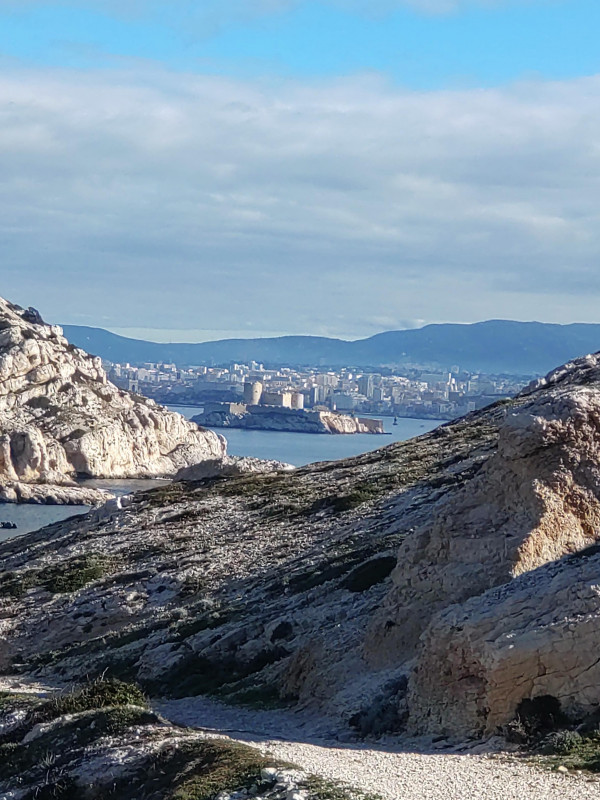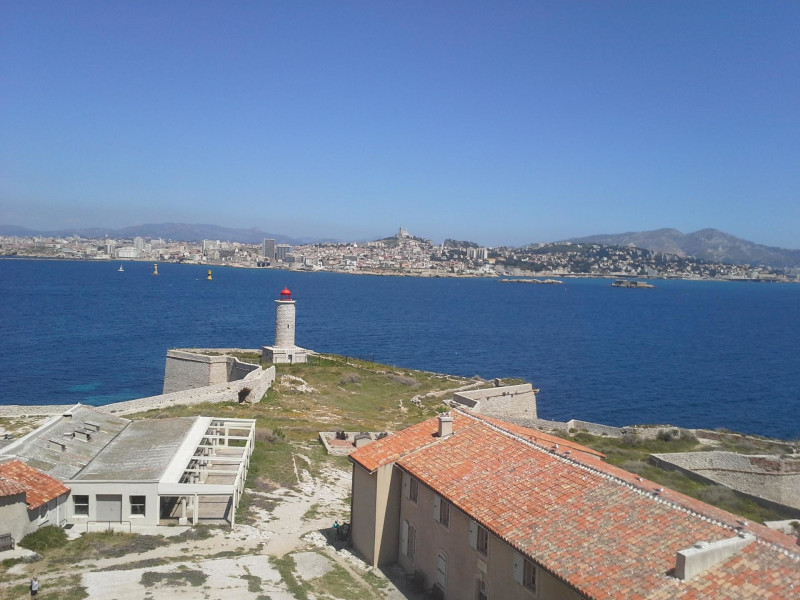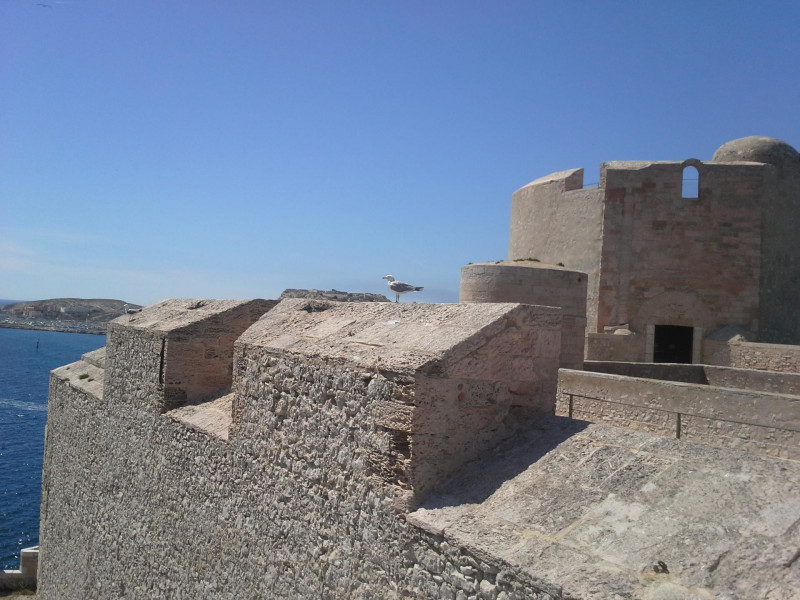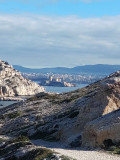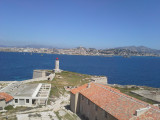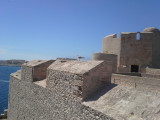The If Castle
Historic site and monumentPresentation
In 1516, François I, King of France, stopped in Marseille after the victory of Marignan. From the island of If, he studied the city's defenses and noted that nothing protected it against invasion.
He then ordered the construction of a fortress on the island. It was only in 1524, after an attack by Charles V, that the first walls of the castle were built to protect the access to the port of Marseille. The construction of the castle was completed in July 1531.
The dreaded Château d'If was never attacked. Thus, the prison function of the château d'If began only a few years after the end of its construction, in the middle of the 16th century. The geographical location of the castle and its architecture made it an ideal prison from which it seemed impossible to escape. The first prisoner was probably the knight Anselme in 1580, then Mirabeau locked up in 1774 on a lettre de cachet. General Kléber was the last famous prisoner, but it was after his death - assassinated in Cairo in 1800 - that he was repatriated to France. His coffin remained in the Château d'If for 18 years.
Following the riots of June 1848, 120 people were imprisoned in the Château d'If. The inscription "Hôtel du peuple souverain" (Hotel of the Sovereign People) which appears above the old access door to the courtyard, dates from this period.
304 prisoners were crammed into If after the coup d'état of December 2, 1852, while awaiting deportation to Algiers and French Guiana.
The legends of the Château d'If
Over the centuries, legends and reality have marked out the history of If. Even before the castle was built, the first supposed prisoner was the only Asian rhinoceros to have touched European soil at that time. It is said that the gift of King Emmanuel of Portugal to Pope Leo X stopped over on the island of Yew during his long journey. For the anecdote, the pope received his gift not alive but stuffed, the ship carrying it having sunk in the bay of Genoa.
The visitor accosting no longer discerns what is reality or imagination. In front of him stands a very real fortress, just like the will of François I to assert the power of the French royalty in Provence.
The Count of Monte Cristo
During his childhood, Dumas heard his father speak of the Château d'If as a place dedicated to the memory of Kleber. In the 19th century, the prison was infamous for its squalid and unsanitary conditions. He visited it for the first time in December 1834, during a trip to the Mediterranean. When he established the plot of his story, between the success of the hero in Rome and his revenge in Paris, he placed the beginning of the plot in Marseille.
In 1842, during a boat trip to the Tuscan archipelago with Prince Jerome Napoleon Bonaparte, Dumas sailed around the small island of Monte Cristo, near the island of Elba. Legend has it that in the Middle Ages, monks chased away an evil dragon. Once they became masters of the archipelago, they collected high royalties on these islands and would have constituted a real treasure, long sought by pirates.
In memory of this discovery, he promised to name one of his novels Monte Cristo, a title that would also echo the land of his Dominican ancestors.
The island of If with the whole archipelago of Frioul is part of the National Park of Calanques.
The guided tour is offered on site every day at 11:15 am, 2:30 pm and 4 pm. A booklet for children and a visit application are also available free of charge.
The dreaded Château d'If was never attacked. Thus, the prison function of the château d'If began only a few years after the end of its construction, in the middle of the 16th century. The geographical location of the castle and its architecture made it an ideal prison from which it seemed impossible to escape. The first prisoner was probably the knight Anselme in 1580, then Mirabeau locked up in 1774 on a lettre de cachet. General Kléber was the last famous prisoner, but it was after his death - assassinated in Cairo in 1800 - that he was repatriated to France. His coffin remained in the Château d'If for 18 years.
Following the riots of June 1848, 120 people were imprisoned in the Château d'If. The inscription "Hôtel du peuple souverain" (Hotel of the Sovereign People) which appears above the old access door to the courtyard, dates from this period.
304 prisoners were crammed into If after the coup d'état of December 2, 1852, while awaiting deportation to Algiers and French Guiana.
The legends of the Château d'If
Over the centuries, legends and reality have marked out the history of If. Even before the castle was built, the first supposed prisoner was the only Asian rhinoceros to have touched European soil at that time. It is said that the gift of King Emmanuel of Portugal to Pope Leo X stopped over on the island of Yew during his long journey. For the anecdote, the pope received his gift not alive but stuffed, the ship carrying it having sunk in the bay of Genoa.
The visitor accosting no longer discerns what is reality or imagination. In front of him stands a very real fortress, just like the will of François I to assert the power of the French royalty in Provence.
The Count of Monte Cristo
During his childhood, Dumas heard his father speak of the Château d'If as a place dedicated to the memory of Kleber. In the 19th century, the prison was infamous for its squalid and unsanitary conditions. He visited it for the first time in December 1834, during a trip to the Mediterranean. When he established the plot of his story, between the success of the hero in Rome and his revenge in Paris, he placed the beginning of the plot in Marseille.
In 1842, during a boat trip to the Tuscan archipelago with Prince Jerome Napoleon Bonaparte, Dumas sailed around the small island of Monte Cristo, near the island of Elba. Legend has it that in the Middle Ages, monks chased away an evil dragon. Once they became masters of the archipelago, they collected high royalties on these islands and would have constituted a real treasure, long sought by pirates.
In memory of this discovery, he promised to name one of his novels Monte Cristo, a title that would also echo the land of his Dominican ancestors.
The island of If with the whole archipelago of Frioul is part of the National Park of Calanques.
The guided tour is offered on site every day at 11:15 am, 2:30 pm and 4 pm. A booklet for children and a visit application are also available free of charge.
Opening period (s)From 01/10/2025 to 31/03/2026 on Tuesday, Wednesday, Thursday, Friday and weekends between 10 am and 5 pm.
Closed exceptionally on 16/01/2026, January 1st and December 25th.
Closed exceptionally on 16/01/2026, January 1st and December 25th.
General information
- Client profile :
- Groups
- Visits :
- you can visit it
- Information panel language(s) :
- Park :
- Calanques National Park
Services, Tours, Activities and entertainment
- Historical patrimony :
- Historic patrimony
- Castle
- Fortified castle
- Help for client/practical :
- Wi-fi
- Entertainment :
- Temporary exhibition
- Visit :
- Guided tours
- Shop :
- Shop
Accessibility
- Accessible to disabled visitors :
- Reception staff sensitized to the reception of people with disabilities
- Not accessible in a wheelchair
Contact
The If Castle
Archipel du Frioul
13007
Marseille
Phone : +33 4 91 59 02 30
Mob : +33 6 03 06 25 26
Tarifs
Full price: 7 €
Group adults: 5.50 €.
Free entry for Job-seeker, the students, disabled people, disabled people and accompanying persons.
Group adults: 5.50 €.
Free entry for Job-seeker, the students, disabled people, disabled people and accompanying persons.

Destination
Château d'If
Archipel du Frioul
13007
Marseille
GPS coordinates
Latitude : 43.2799
Longitude : 5.32596



